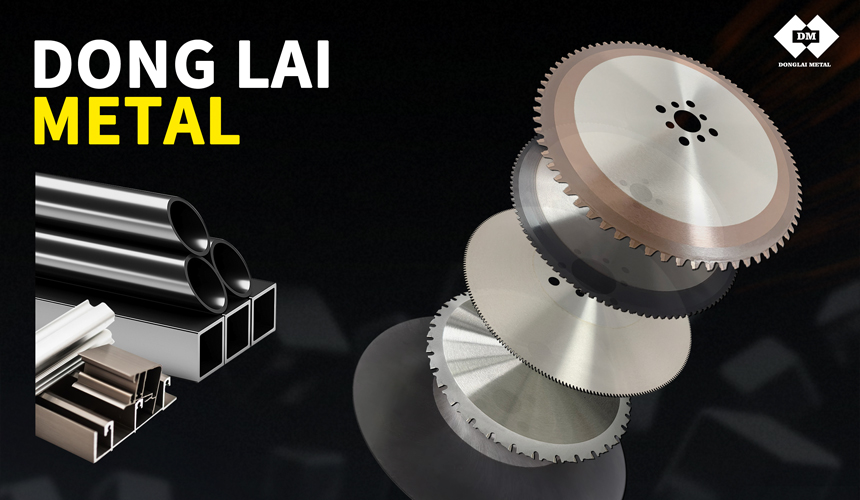- Super User
- 2025-05-09
Kiel feraj tranĉaj segaj klingoj povas certigi la precizecon kaj efikecon de met
Subjekto : Kiel Fera Tranĉanta Klingoj povas certigi la precizecon kaj efikecon de metala prilaborado?
Feraj tranĉaj segiloj certigas la precizecon kaj efikecon de metala prilaborado tra la jenaj aspektoj:
1. altkvalitaj materialoj
High hardness and wear resistance: The blade head of the iron cutting saw blade is usually made of high hardness materials such as carbide and high-speed steel.Take carbide alloy as an example. It is composed of metal carbide and binder, and its Rockwell hardness can reach 89-93HRA, which is much higher than that of steel materials.This allows the saw blade to remain sharp during the cutting process and is less likely to wear, thus ensuring accurate and continuous cutting.
Good toughness: In addition to hardness, the saw blade material also needs to have a certain toughness to prevent the blade from chipping due to impact during the cutting process.For example, the binder in cemented carbide provides the necessary toughness for the saw blade, while high-speed steel itself has good toughness and can withstand a certain degree of impact, ensuring the stability of the saw blade when cutting and processing hard metal at high speed.
2. Rezulta segilo -dezajno
Sawtooth shape: Different sawtooth shapes are suitable for different cutting scenarios.Left and right teeth (alternating teeth) are the most common shape. The alternating tooth edge arrangement can generate greater cutting force and smooth chip removal, which can effectively avoid chip blockage, improve cutting efficiency and quality,and is suitable for the cutting of most steel materials.The wave teeth have stronger anti-vibration performance. When cutting large-sized or thick-walled steel pipes and profiles, they can reduce vibration, make the cutting surface smoother, and ensure cutting accuracy.
Tooth pitch selection: The size of the tooth pitch needs to be reasonably matched according to the thickness and hardness of the cutting material.For thinner and softer steel materials, using a smaller pitch can increase the number of cutting edges per unit length, making the cutting more precise and reducing the roughness of the cutting surface.For thick-walled, high-strength steel materials, a larger tooth pitch can increase the cutting amount of a single tooth edge, preventing the Denta rando de esti damaĝita pro superŝarĝo. Ĝi ankaŭ estas utila por forigo de ĉifonoj kaj konservas efikan tranĉadon.

3. Precizi Fabrikan Procezon
Dimensional accuracy control: In the manufacturing process of saw blades, strict control of dimensional accuracy is essential.From the diameter and thickness of the saw blade to the angle and height of the saw teeth, all parameters need to be precisely processed to ensure the stability of the saw blade and the accuracy of cutting when rotating at high speed.For example,a high-precision saw blade can maintain straightness during cutting, avoiding cutting deviations kaj tiel plibonigante pretigan precizecon.
Surface quality optimization: The surface quality of the saw blade directly affects the cutting effect.Through fine grinding and polishing processes, the saw blade surface can reach a lower roughness, which can reduce friction resistance during cutting, reduce cutting heat generation, and thus improve cutting efficiency and quality.At the same time, good surface quality can prevent chips from adhering to the saw blade and affecting cutting accuracy.
4. Aldonita ekipaĵo kaj teknologio
Altfrekvencaj tranĉaj ekipaĵoj: Kombine kun altnivelaj tranĉaj ekipaĵoj kiel CNC-segilmaŝinoj, ĝi povas atingi precizan kontrolon de la feraj tranĉaj segaj klingoj. Ĉi tiuj aparatoj estas ekipitaj per alt-precizaj transdono kaj kontrolaj sistemoj, kiuj povas precize kontroli la nutran indicon de la segilo, tranĉa rapideco, tio, kio certigas la stabilecon kaj ripetadon de la metalo de la metalo de la metalo.
Inteligenta Monitorado -Teknologio: Iuj altnivelaj tranĉaj ekipaĵoj ankaŭ estas ekipitaj per inteligenta monitorada sistemo, kiu povas monitori diversajn parametrojn en la tranĉa procezo en reala tempo, kiel la eluziĝo de la sega klingo, ŝanĝoj en tranĉa forto, ktp. Kiam oni detektas anormalecon, la sistemo aŭtomate ĝustigos la tranĉajn parametrojn aŭ al la ŝaltilo kaj la ŝaltilo kaj la ŝaltilo kaj ne taŭgas por ke la funkciigilo estu ne plifortigi la funkciigiston kaj pliigi la funkciigiston kaj pli ol
5. Korekta uzo kaj bontenado
Akcepteblaj tranĉaj parametraj agordoj: Laŭ la materialo kaj dikeco de la metalo tranĉita, racie ĝustigu la tranĉan rapidecon, nutradon kaj tranĉan uzadon de fluido. Ekzemple, por ŝtalaj materialoj kun pli alta malmoleco, la tranĉa rapideco devas esti taŭge reduktita, la nutrado devas esti pliigita, kaj taŭga tranĉa fluido devas esti elektita por malvarmigo kaj lubrikado por redukti la uzon de ŝvelaĵo por pliigi la ŝvebadon.
Regula bontenado kaj prizorgado: Regula inspektado, purigado, muelado kaj anstataŭigo de la feraj tranĉaj segiloj povas plilongigi sian servan vivon kaj certigi ĝian stabilan rendimenton. Malplenigu la blatojn kaj malpuraĵojn sur la sega klingo ĝustatempe por malebligi ilian akumuladon kaj influi la tranĉan efikon. Kiam la sega klingo surhavas ian mezuron, anstataŭigu ĝin per nova ĝustatempe por certigi tranĉan precizecon kaj efikecon.
-
Nova akcelo por prilaborado Ne Sekva














